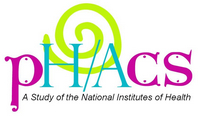Overview
 PHACS began in 2005 to address two critical pediatric HIV research questions:
PHACS began in 2005 to address two critical pediatric HIV research questions:
- What is the long-term safety of fetal and infant exposure to antiretroviral (ARV) therapy (ART)?
- What are the effects of perinatally acquired HIV in adolescents?
PHACS is funded through a Program Project Grant (P01) by the NICHD Maternal and Pediatric Infectious Disease Branch, National Institute on Alcohol Abuse and Alcoholism, National Institute of Allergy and Infectious Diseases, National Institute on Deafness and Other Communication Disorders, National Institute of Dental and Craniofacial Research, National Institute on Drug Abuse, National Institute of Mental Health, National Institute of Neurological Disorders and Stroke, National Cancer Institute, National Heart, Lung, and Blood Institute, and the NIH Office of the Director.
PHACS comprises 21 clinical sites 

The overall goals of this network are the following:
- Understand how HIV and its treatment affect growth and development, sexual maturation, organ function, and socialization of pre-adolescents, adolescents, and young adults who acquired HIV perinatally
- Acquire more definitive information on the long-term safety of ART when used during pregnancy and in newborns
- Ensure a mechanism is in place to estimate the upper bounds of risk for children who were exposed to ART during maternal treatment to prevent perinatal HIV transmission
- Continue the follow-up study of these populations
Topic Areas
PHACS conducts and has conducted multiple studies. Please visit the Studies section 
PHACS studies examine the effects and risk factors related to HIV acquisition, ARV use, and ART exposure in developing children and youth:
- Neurodevelopmental, cognitive, academic, vocational, behavioral, and social outcomes
- Impairment of hearing, language, and learning and other communication disorders
- Substance use and mental health outcomes
- Adherence to treatments and interventions
- Growth, endocrinology, and bone development
- Sexual maturation, gynecology, reproductive capacity, sexual health, and HIV risk behaviors
- Nutrition, body composition, and tissue redistribution syndromes
- Cardiovascular complications and disease risk
- Genetics and epigenetics related to HIV acquistion, ARV treatment, and ART exposure
- Effects of maternal substance use on child outcomes
- Oral health
- Pulmonary complications
- Renal complications
More Information
- PHACS Website
- NICHD Contact: Denise Russo and Sonia Lee
 BACK TO TOP
BACK TO TOP